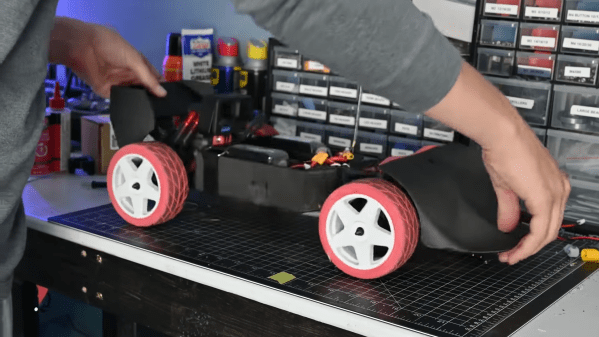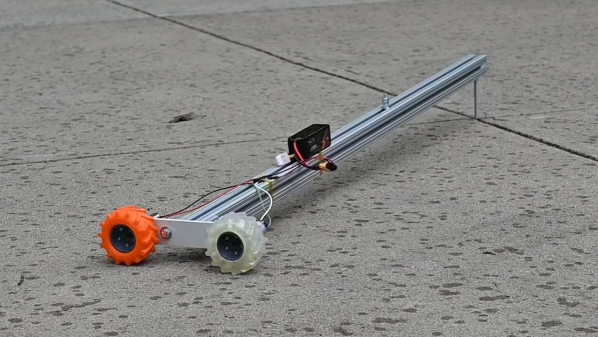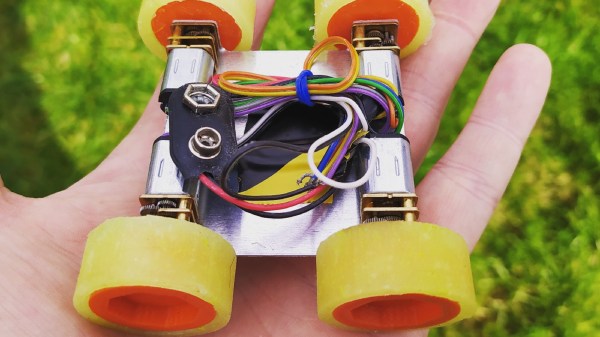Things may not have gone as planned last week for the flying cellphone on Mars, but just because Ingenuity‘s flying career is over doesn’t mean there’s no more work to do. NASA announced this week that it’s going to try a series of “wiggle” maneuvers on Ingenuity‘s rotors, in an attempt to get a better look at the damage to the blade tips and possibly get some clues as to what went wrong. The conjecture at the moment seems to be that a large area of relatively featureless terrain confused the navigation system, which uses down-facing cameras to track terrain features. If the navigation program couldn’t get a bead on exactly how far above the ground it was, it’s possible the copter came in too hard and caused the rotor tips to dig into the regolith. There seems to be some photographic suggestion of that, with what looks like divots in the ground about where you’d expect the rotor tips to dig in, and even scraps of material that look out of place and seem to be about the same color as the rotor blades. All this remains to be seen, of course, and we’re sure that NASA and JPL are poring over all available data to piece together what happened. As much as we hate to say goodbye to Ingenuity, we eagerly await the post-mortem.
tires11 Articles
3D Printing RC Car Tires To Go Fast
There’s a bit of a high-speed arms race in the RC world on YouTube these days. [Michael Rectin] is in on the action, and he’s been exploring how to 3D print a decent set of tires to help his RC car reach higher speeds mph.
His first efforts involved experiments with TPU. The tires looked okay, but had very little traction. He later moved on to VarioShore TPU, a filament capable of delivering various properties depending on the printing method. Printing for the softest, and thus grippiest, possible tires, [Michael] whipped up some sporty looking boots for his wheels.
His tires improved over off-road RC tires in one major way. His design didn’t suffer significant ballooning as the rotational velocity increased. However, the VarioShore material lacked grip compared to off-the-shelf rubber RC tires designed for high-speed use. The commercially-available tires also offered a smoother ride.
[Michael] also demonstrated some neat tricks for high-speed RC driving. He used a modified flight controller to correct the car’s steering in response to perturbations, and put in a scaling method that reduces steering inputs at higher speed. That didn’t entirely stop the carnage though, with some incidents seeing wheels thrown off in big tumbling crashes.
Electric-powered RC cars can go darn quick these days, but you might want to consider jet power if you want to break records. Video after the break.
Hackaday Links: December 25, 2022
Looks like it’s lights out on Mars for the InSight lander. The solar-powered lander’s last selfie, sent back in April, showed a thick layer of dust covering everything, including the large circular solar panels needed to power the craft. At the time, NASA warned that InSight would probably give up the ghost sometime before the end of the year, and it looks like InSight is sticking to that schedule. InSight sent back what might be its last picture recently, showing the SEIS seismic package deployed on the regolith alongside the failed HP3 “mole” experiment, which failed to burrow into the soil as planned. But one bad experiment does not a failed mission make — it was wildly successful at most everything it was sent there to do, including documenting the largest marsquake ever recorded. As it usually does, NASA has anthropomorphized InSight with bittersweet sentiments like “Don’t cry, I had a good life,” and we’re not quite sure how we feel about that. On the one hand, it kind of trivializes the engineering and scientific accomplishments of the mission, but then again, it seems to engage the public, so in the final rinse, it’s probably mostly harmless.
Comparing 3D Printed Tires: Resin Vs. TPU
Many robot builders and RC enthusiasts find themselves turning to 3D printed tires. The benefit is you can make them in any size and style you want, and they’re as readily available for as long as your home printer is still working. [Michael Rechtin] printed some up and decided to see how long they’d actually last in use.
[Michael] printed a pair of tires for the test. One was made in TPU on a typical FDM printer, while the other was printed in flexible resin. The tires were then installed on hubs and fitted with gear motors for drive. The assembly was then fitted to the end of a test tether that would turn in circles for hours to put mileage on the tires.
After many hours and around 10 miles of testing, both tires were showing signs of wear. Notably, the resin tires showed a lot more wear than the TPU version, suggesting the latter material is a better choice for printing hard-wearing tires.
Overall, it’s reminiscent of the tether testing we saw from [rctestflight] recently. There’s something compelling about thrashing something round in circles to learn something in the process! Video after the break.
Continue reading “Comparing 3D Printed Tires: Resin Vs. TPU”
Do Flat Tyres Make Your Speedo Lie?
There are some engineering questions that may not have huge importance in the world, but which become the subject of intense idle speculation. A good example is the question of whether a lower tyre pressure on a motor vehicle would make a difference to the indicated speed. There are several contrasting intuitive theories as to what should happen, so [] has taken the time for a bit of experimentation in order to find out what really happens.
At stake were the change in effective radius from a flattened portion of the tyre, the so-called tank tracks effect in which the entire circumference of the tyre is still traversed, and the prospect of a change in circumference due to the different pressure. The test wheels were made from foam, and were found to give a different reading when compressed. This might solve toe problem, but of course real car wheels have radial wires to give them stiffness. When these were simulated on the foam wheels with packing tape, the difference evaporated. Later this was confirmed by GPS-measuring a real car with deflated wheels.
All this makes for a fascinating read, because after all, there’s sometimes no substitute for a real-world test.
Header image: Gerlach, Public domain.
Solid Tips For Casting Colored Silicone Tires
For people who work with wheeled robots or RC vehicles, sooner or later one gets interested in making custom tires instead of dealing with whatever is available off the shelf. [concreted0g]’s preferred method is to design and 3D print wheel hubs, then cast some custom silicone tires to fit over them. Of course, the devil is in the details and this process can be a bit messy, so he’s shared useful tips on how to get reliable results with simple materials.
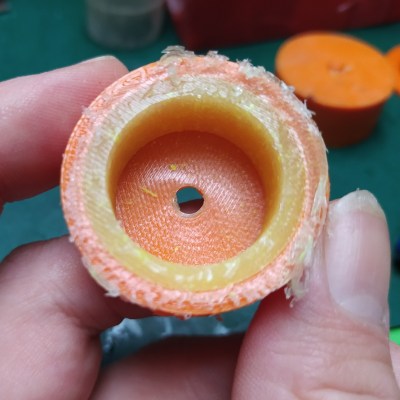 The casting material is cheap silicone caulking from a hardware store, and color can be added with a small amount of cheap acrylic paint. A few drops of glycerin added to the silicone thins it out slightly and helps it flow into a mold better. Mix well (the paint will also serve as a visual indicator of how well it is mixed), then scoop the mixture into the mold while trying to avoid creating air pockets. If your mold is in two pieces, assemble the mold and remove any overflow, then let it sit undisturbed for at least several hours while it cures.
The casting material is cheap silicone caulking from a hardware store, and color can be added with a small amount of cheap acrylic paint. A few drops of glycerin added to the silicone thins it out slightly and helps it flow into a mold better. Mix well (the paint will also serve as a visual indicator of how well it is mixed), then scoop the mixture into the mold while trying to avoid creating air pockets. If your mold is in two pieces, assemble the mold and remove any overflow, then let it sit undisturbed for at least several hours while it cures.
Mounting the resulting tire to a wheel hub can be done with a thin film of super glue, which seems to work perfectly well for small tires and is easy to apply.
The rules are going to be a bit different for big objects. We know that silicone caulking can have difficulty fully curing when it’s applied thickly, especially when sealed into a mold with little to no airflow. In such cases, adding cornstarch (in about a 5:1 ratio of silicone to cornstarch by volume) is all that it takes to cure even thick wads of goop in less than an hour. Stirring cornstarch in tends to introduce more air bubbles into the mixture, but for larger pieces that can be an acceptable tradeoff. Cheap silicone caulking is versatile stuff, one just needs to know what to expect, and take a few steps to deal with the messiness.
Need something tougher? Maybe check out using slices of automotive silicone hose for robot wheels to get something that works just as well, but is a lot more durable.
3D Printed Wheels Get Some Much Needed Grip
You’d be hard-pressed to find more ardent supporters of 3D printing then we here at Hackaday; the sound of NEMA 17 steppers pushing an i3 through its motions sounds like a choir of angels to our ears. But we have to admit that the hard plastic components produced by desktop 3D printers aren’t ideal for a number of applications. For example, the slick plastic is useless for all but the most rudimentary of wheels. Sure there are flexible filaments that can give a printed wheel a bit of grip, but they came with their own set of problems (not to mention, cost).
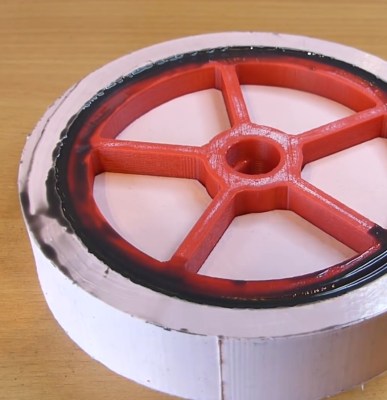 In the video after the break, [Design/Forge] demonstrates a clever method for fitting polyurethane rubber “tires” onto 3D printed hubs which is sure to be of interest to anyone who’s in the market for high quality bespoke wheels for their project. The final result looks extremely professional, and while there’s a considerable amount of preparation that goes into it, once you’re set up you should be able to pump these out quickly and cheaply.
In the video after the break, [Design/Forge] demonstrates a clever method for fitting polyurethane rubber “tires” onto 3D printed hubs which is sure to be of interest to anyone who’s in the market for high quality bespoke wheels for their project. The final result looks extremely professional, and while there’s a considerable amount of preparation that goes into it, once you’re set up you should be able to pump these out quickly and cheaply.
The process begins with a 3D printed mold pattern, which includes the final tire tread texture. This means you can create tire treads of any design you wish, which should have some creative as well as practical applications. The printed part is then submerged in silicone rubber and allowed to cure for 8 hours. Once solidified, the silicone rubber becomes the mold used for the next steps, and the original printed part is no longer needed.
The second half of the process is 3D printing the wheels to which the tires will be attached. These will be much smaller than the original 3D printed component, and fit inside of the silicone mold. The outside diameter of the printed wheel is slightly smaller than the inside diameter of the mold, which gives [Design/Forge] the space to pour in the pigmented polyurethane rubber. The attentive viewer will note that the 3D printed wheel has a slight ribbed texture designed into it, so that there will be more surface area for the polyurethane to adhere to. Once removed from the mold and cleaned up a bit, the final product really does look fantastic; and reminds us of a giant scale LEGO wheel.
Whether you’re casting metal parts or just want a pair of truly custom earbuds, creating silicone molds from 3D printed parts is an extremely useful skill to familiarize yourself with. Though even if you don’t have a 3D printer, there’s something to be said for knowing how to mold and cast real-world objects as well.
Continue reading “3D Printed Wheels Get Some Much Needed Grip”


